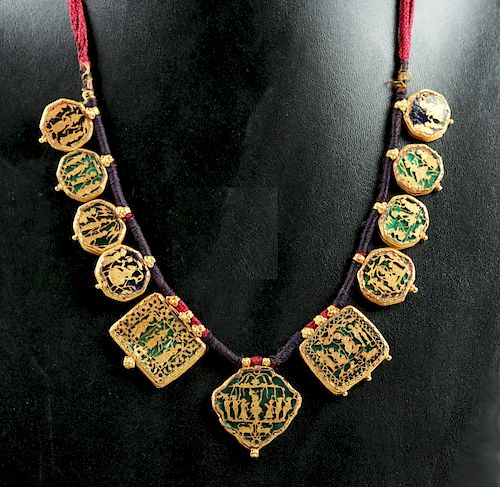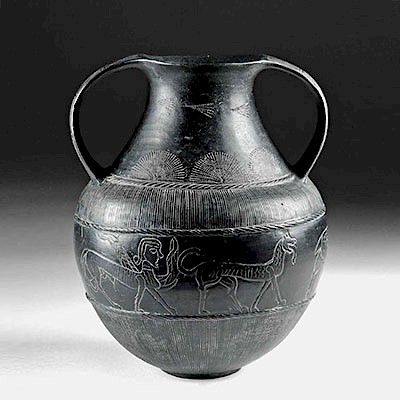18th C. Indian 22K+ Gold-Over-Glass Thewa Necklace
Lot 118
About Seller
Artemis Gallery
686 S Taylor Ave, Ste 106
Louisville, CO 80027
United States
Selling antiquities, ancient and ethnographic art online since 1993, Artemis Gallery specializes in Classical Antiquities (Egyptian, Greek, Roman, Near Eastern), Asian, Pre-Columbian, African / Tribal / Oceanographic art. Our extensive inventory includes pottery, stone, metal, wood, glass and textil...Read more
Categories
Estimate:
$18,000 - $25,000
Absentee vs Live bid
Two ways to bid:
- Leave a max absentee bid and the platform will bid on your behalf up to your maximum bid during the live auction.
- Bid live during the auction and your bids will be submitted real-time to the auctioneer.
Bid Increments
| Price | Bid Increment |
|---|---|
| $0 | $25 |
| $300 | $50 |
| $1,000 | $100 |
| $2,000 | $250 |
| $5,000 | $500 |
| $10,000 | $1,000 |
| $20,000 | $2,500 |
| $50,000 | $5,000 |
| $100,000 | $10,000 |
| $200,000 | $20,000 |
About Auction
By Artemis Gallery
Mar 21, 2019
Set Reminder
2019-03-21 10:00:00
2019-03-21 10:00:00
America/New_York
Bidsquare
Bidsquare : Fine Ancient | Asian | Ethnographic Art
https://www.bidsquare.com/auctions/artemis-gallery/fine-ancient-asian-ethnographic-art-3967
Featuring classical antiquities, ancient and ethnographic art from cultures encompassing the globe, plus fine art. Egyptian, Greek, Roman, Etruscan, Near Eastern, Asian, Pre-Columbian, Native American, African / Tribal, Oceanic, Spanish Colonial, Russian, Fine Art, so much more! Artemis Gallery info@artemisgallery.com
Featuring classical antiquities, ancient and ethnographic art from cultures encompassing the globe, plus fine art. Egyptian, Greek, Roman, Etruscan, Near Eastern, Asian, Pre-Columbian, Native American, African / Tribal, Oceanic, Spanish Colonial, Russian, Fine Art, so much more! Artemis Gallery info@artemisgallery.com
- Lot Description
Northwest India, Rajasthan, Pratapgarh, ca. 18th century CE. A stunning thewa (also theva) necklace featuring eleven pendants made via a painstaking technique involving 22K+ gold sheet and colorful blue and green Belgian glass that originated in the town of Pratapgarh in Rajasthan. Today most thewa is from Gujarat, but these pendants were made in Pratapgarh, where this the technique originated. Invented in 1767 by a local goldsmith named Nathuni Sonewalla, this technique - which requires the highest level of skill - was passed down from father to son, and was safeguarded in secrecy by a few goldsmith families until the 20th century. This example features marvelously intricate Hindu iconography delineated in gold in miniature over lustrous green and blue Belgian glass and is strung on twisted pink and purple embroidery thread. Size: central pendant 1.25" L x 1.25" W (3.2 cm x 3.2 cm); necklace is 23" L (58.4 cm); total weight 59.5 grams
Each thewa piece can take up to a month to create - as the work is quite intricate. First designs inspired by Hindu mythology or Mughal court scenes, flora and fauna, or historical events are punched out of very thin high karat gold sheet on a board that is covered with a thin layer of lac. The lac is heated and the metal sheet is pressed into it and peeled off after it cools. Next, the gold sheet is laid on top of the glass, heated once again until the metal fuses with the glass surface.
Passed from one generation to the next in only four families, the thewa process was a closely guarded secret for years, making this piece extremely precious today! In addition, this piece is an example of Thewa art made by an important family of Pratapgarh in Rajasthan where this art form was born. As an 18th century piece, the motifs and symbolism of this necklace are very unusual compared to most modern examples. Truly a museum quality example!
See a bracelet made via the thewa technique at the Metropolitan Museum of Art (Accession No. 60.159) - https://www.metmuseum.org/art/collection/search/451629
Provenance: private House of Indus collection
All items legal to buy/sell under U.S. Statute covering cultural patrimony Code 2600, CHAPTER 14, and are guaranteed to be as described or your money back.
A Certificate of Authenticity will accompany all winning bids.
We ship worldwide and handle all shipping in-house for your convenience.
#138180The pendant to the left of the central pendant has an indentation. There is slight denting to versos of all the pendants and expected age patina to the gold. Flower petals of loop to one pendant are missing. Normal wear commensurate with age, but generally excellent.Condition
- Shipping Info
-
All shipping is handled in-house for your convenience. Your invoice from Artemis Gallery will include shipping calculation instructions. If in doubt, please inquire BEFORE bidding for estimated shipping costs for individual items.
-
- Buyer's Premium



 EUR
EUR CAD
CAD AUD
AUD GBP
GBP MXN
MXN HKD
HKD CNY
CNY MYR
MYR SEK
SEK SGD
SGD CHF
CHF THB
THB















